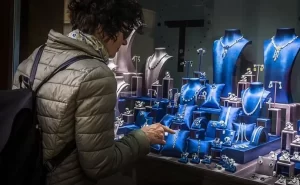Modern Elegance or Timeless Craft? The Financial Case for Premium Menswear
The Exclusive World of Luxury Menswear
The luxury menswear market thrives on the allure of exclusivity, exceptional craftsmanship, and enduring value. Among the most prestigious names in bespoke tailoring are Tom Ford and Kiton, each with its unique narrative and legacy. For enthusiasts and investors alike, these brands represent not only the epitome of style but also compelling financial considerations. As the demand for bespoke tailoring evolves, the choice between Tom Ford and Kiton extends beyond aesthetics, encompassing investment potential, market performance, and cultural relevance.
Modern Elegance vs. Traditional Craftsmanship
Tom Ford, a relative newcomer to the bespoke arena, has rapidly established itself as a symbol of modern elegance and Hollywood glamour. Its distinctive approach—bold, innovative, and inherently contemporary—resonates with the dynamic tastes of the 21st-century luxury consumer. In contrast, Kiton, steeped in tradition and rooted in Neapolitan tailoring techniques, appeals to connoisseurs who value heritage and artisanal craftsmanship. This juxtaposition sets the stage for an intriguing comparison, offering insights into how these brands fare as both fashion icons and financial assets.
Dissecting the Investment Landscape
Comparative Investment Analysis
Tom Ford: Revolutionary Luxury with Future Growth
Tom Ford’s strategy hinges on redefining luxury tailoring for the modern age. By merging cutting-edge technology with artisanal methods, the brand delivers garments that are as innovative as they are iconic. Features like computer-aided design and enhanced fitting protocols ensure precision, while its bold aesthetic—characterized by sharp silhouettes and avant-garde fabric treatments—sets it apart.
The Financial Profile of Tom Ford
From an investment perspective, Tom Ford offers promising growth. With a five-year value retention rate of 65-75%, its bespoke suits are gaining traction among collectors. The brand’s association with high-profile events and celebrities amplifies its allure. For instance, its partnership with major film franchises and red-carpet appearances has significantly bolstered its market presence. Although its first-year depreciation rate of 15-20% is notable, this is mitigated by its rising secondary market demand and emerging status in luxury auctions.
Kiton: The Enduring Standard of Elegance
Kiton’s unwavering commitment to traditional craftsmanship is its hallmark. Each bespoke garment reflects over 95 hours of meticulous handwork, embodying techniques passed down through generations. The brand’s focus on natural shoulder constructions, hand-rolled details, and exclusive fabrics ensures that every piece is a testament to Neapolitan tailoring excellence.
Kiton’s Investment Credentials
Investment-wise, Kiton’s stable value retention—70-80% over five years—makes it a reliable choice for conservative investors. Its lower first-year depreciation of 10-15% reflects its enduring appeal and established presence in luxury auctions. Kiton’s reputation as a collector’s favorite is further reinforced by its consistent performance in high-profile auctions, where heritage pieces command premium prices. Starting at $14,000, Kiton’s bespoke offerings represent a significant investment, but one that is backed by a strong history of value appreciation.
The Shifting Landscape of Luxury Fashion
Cultural Relevance and Market Trends
Bespoke Tailoring in the Modern Era
The resurgence of interest in bespoke tailoring is driven by shifting consumer priorities. Sustainability, authenticity, and personalization have emerged as key factors influencing buying decisions. Tom Ford has tapped into these trends with initiatives focused on eco-friendly materials and innovative tailoring techniques. Its modern, fashion-forward image continues to attract younger demographics, ensuring its relevance in a rapidly changing market.
Heritage Meets Contemporary Values
Kiton, while deeply traditional, has also adapted to contemporary sensibilities. Its commitment to ethical sourcing and sustainable practices aligns with the values of today’s discerning consumers. Additionally, Kiton’s collaborations with luxury platforms and participation in events like Pitti Uomo reinforce its status as a bastion of heritage craftsmanship.
Market Insights from 2024
Auction data from 2024 highlights the growing demand for both brands. Tom Ford’s limited-edition pieces and celebrity-endorsed designs are increasingly sought after, while Kiton’s timeless creations remain a staple among serious collectors. This dual appeal underscores the resilience and adaptability of bespoke tailoring in the luxury segment.
Making the Ultimate Luxury Investment Decision
Conclusion
Innovation vs. Tradition: The Final Verdict
The decision between Tom Ford and Kiton ultimately boils down to individual priorities. Tom Ford offers an exciting proposition for those who value innovation, bold aesthetics, and the potential for market growth. On the other hand, Kiton represents a steadfast commitment to tradition, providing stability and enduring value for long-term investors.
Beyond Fashion: Investing in Artistry
Both brands embody the pinnacle of bespoke tailoring, yet they cater to distinct preferences and investment strategies. Whether one gravitates toward the modern elegance of Tom Ford or the timeless refinement of Kiton, these garments transcend fashion to become enduring symbols of artistry and sophistication.
Industry Research and Market Reports
References
Luxury Institute Bespoke Tailoring Report 2024
Financial Times: Bespoke Market Insights 2024
Sotheby’s Auction Trends Report 2024
Business of Fashion: Tailoring and Sustainability 2024
Neapolitan Tailoring Journal 2024













